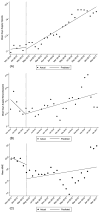Mandatory review of a prescription drug monitoring program and impact on opioid and benzodiazepine dispensing
- PMID: 29778769
- PMCID: PMC6528173
- DOI: 10.1016/j.drugalcdep.2018.03.036
Mandatory review of a prescription drug monitoring program and impact on opioid and benzodiazepine dispensing
Abstract
Background: The purpose of this study is to determine whether Ohio House Bill 341, which mandated the use of Ohio's Prescription Drug Monitoring Program (PDMP), was an effective regulatory strategy to reduce opioid and benzodiazepine dispensing.
Method: Secondary analysis of Ohio's PDMP data on prescription opioids and benzodiazepines dispensed from November 2014 to March 2017. An interrupted time series analysis was conducted to determine if there was a significant change in the quantity of opioids and benzodiazepines dispensed.
Results: After HB341 became effective in April 2015, there was a statistically significant decrease in the monthly quantity (number of pills) opioids and benzodiazepines dispensed in Ohio. There was a modest increase in the mean days' supply of opioids and no change in the mean morphine equivalent dose.
Conclusions: Legislation in Ohio requiring prescribers to check the PDMP was effective in reducing the quantity of opioids and benzodiazepines dispensed.
Keywords: Benzodiazepines; Dispensing; Policy; Prescription opioids.
Copyright © 2018 Elsevier B.V. All rights reserved.
Conflict of interest statement
No conflict declared.
Figures



References
-
- American College of Emergency Physicians. Electronic prescription drug monitoring program. Ann Emerg Med. 2017;70:116–117. - PubMed
-
- Brown R, Riley MR, Ulrich L, Kraly EP, Jenkins P, Krupa NL, Gadomski A. Impact of New York prescription drug monitoring program, I-STOP, on state-wide overdose morbidity. Drug Alcohol Depend. 2017;178:348–354. - PubMed
-
- Burke J. The value of prescription monitoring programs. [Accessed 22 February 2018];Pharmacy Times. 2016 Available from http://www.pharmacytimes.com/publications/issue/2016/september2016/the-v....
Publication types
MeSH terms
Substances
Grants and funding
LinkOut - more resources
Full Text Sources
Other Literature Sources
Miscellaneous

